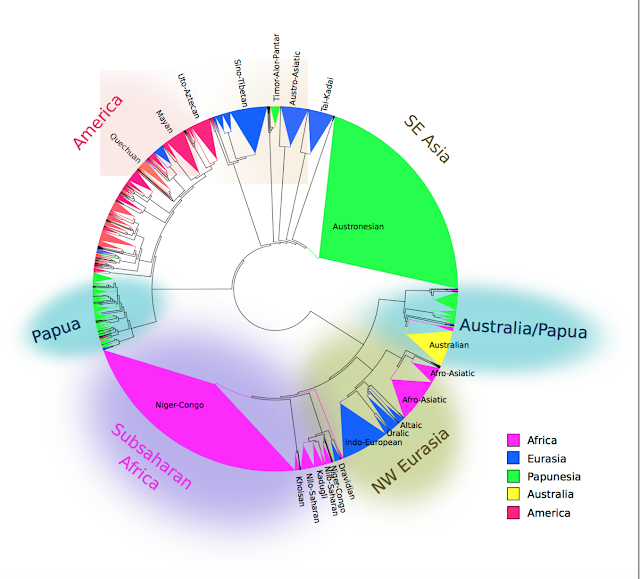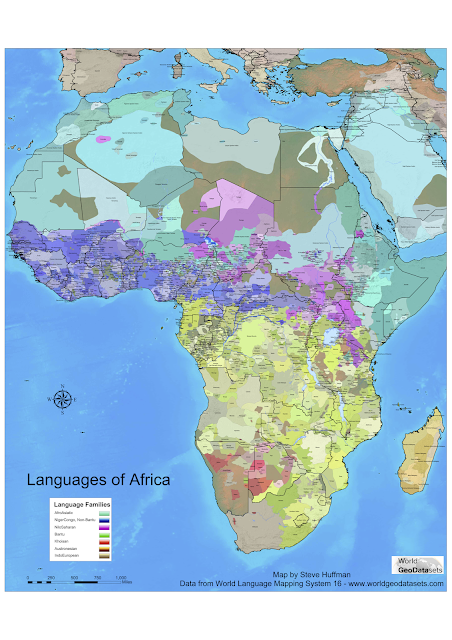A week of Bantu grammar reading: The good, the bad, and the ugly
In my week of grammar reading, there were some truly good,
truly bad, and truly ugly aspects. It was entirely devoted to
Bantu, as it has been for some time, because of a project on Bantu gender systems I am doing together with Francesca Di Garbo of Stockholm University. Bantu languages are best known for their complex morphology, both involving the noun (gender) and the verb (Tense-Mood-Aspect). The noun typically is classified in up to around 12 different genders, signified by prefixes that attach to the noun root, and prefixes that mark agreement with the noun throughout the clause. To start with the good, below is an overview of nominal prefixes in Ding (diz), spoken in the Democratic Republic of Congo. The Roman numerals in the first column signify each gender, the two subsequent columns relate the singular and plural prefixes used for nouns, including different forms, and the final column gives examples of the type of noun found in each gender.
Mertens (1938: 26)
By far the large majority of Bantu languages have systems such as Ding. What we are looking for in this project is not the presence of gender systems per se, but rather variation regarding the number of genders, the places where gender marking is found aside from on the noun, and occasions when agreement is not based on gender, but rather on animacy - more on latter the below. We look for over 20 different word classes that may carry agreement marking: attributive adjectives, demonstratives, genitives, predicative nominals, possessive pronouns, and so on. Many of these do have gender agreement in many Bantu languages, but unfortunately this is not always very well described.
The Ding grammar by Joseph Mertens is in one word, AWESOME. It is part of a three-volume description of ethnography, grammar, and lexicon, in total of over 1000 pages. The grammar is very extensive, features many examples, and is written clearly and honestly - the author did not find out exactly how relative clauses work in Ding, and just says this. Yay! And, as it turns out, agreement is not always assigned on the basis of gender. Below is a full overview of page 64 and 65, where demonstratives are described. In Table 1, the demonstratives for each gender are given - for each gender (I-VII) and number (SG/PL), there is a separate demonstrative, which bear some similarity to the nominal markers above.
Mertens (1938: 64-65)
The first example on this page shows how gender agreement works: muur wu tɛɛn ntɛɛn 'cet homme bavarde' - muur means man, it starts with the mu- prefix for singular gender I. wu means something like 'this', i.e. it is a demonstrative that indicates something is located close to the speaker. It agrees with the noun muur, and is also singular gender I. This is the status quo: different parts of the clause, such as the demonstrative, are marked for the same gender as the (subject) noun. However, many Bantu languages diverge from this by allowing agreement to not reflect gender assignment, but rather to reflect animacy. Mertens describes this just below the first set of examples: "a) Des noms de personnes, appartenant à d’autres classes que la première, en adoptent pourtant le démonstratif." Nouns that designate humans, even if they belong to a different gender, take the demonstrative of the singular gender I. The first gender typically contains nouns designating persons, such as kinship terms, and thus by assigning human nouns agreement in the first gender, the animacy status of these nouns is appropriately flagged. As Mertens continues, in Ding, the same is true for animals: "b) Même remarque pour les noms d’animaux", which is not unreasonable, as many animals in stories have human-like qualities. In Ding, animacy-based agreement is also found on verbs, but not for any of the other parts of the clause we looked at.
Francesca also had a great find this week on Bangi (bin), spoken in Congo, the Democratic Republic of Congo, and the Central African Republic, it is worth reading in full:
Whitehead (1899: 8)
This passage contains so many (implicit) claims about language use, second language acquisition, contact-induced change, simplification, prescriptivism, prestige, it is really something special. The processes in noun class reduction through contact-induced change are one of the things we are trying to study in this project. Also, it points out the problem that we face in trying to uncover animacy-based agreement, or other types of agreement - some grammar writers will not report on these deviances from 'regular' gender-based agreement.
To continue with the bad. This week I was also looking on information on Tsaangi (tsa), spoken in Congo and Gabon. I went looking for the following two references:
Loubelo, Fidèle. (1987) Description phonologique du itsaangi, parler de Madouma-Mossendjo. Brazzaville: Université Marien Ngouabi MA thesis.
Loubelo, Fidèle. (1990) Le nom en kitsa:ngi, langue bantoue du Congo. Dakar: Université Cheikh Anta Diop doctoral dissertation.
Since one of these references focuses especially on the noun, I tried to look around on the internet to see if I could find the author and ask them whether they might be able to share their work. I found their name mentioned in at least three places (here and here and here), mentioning that this person was murdered in late 1998, during the Republic of Congo Civil War. This could be another person with the same name, but the sources mention this person was a minister, and being a minister and a linguist may very well go hand in hand, with many people studying Bantu languages that are ultimately employed by Christian organizations to translate the Bible. This was such a saddening finding. The wars fought in Africa and those still being fought today are horrible.
This leaves us at the ugly. I usually don't like to speak ill of other people's work, and this classification is partly in jest - normally I would classify the following simply as 'bad'. But this week I read a grammar of a Bantu language that did not discuss the gender system at all - despite there in all likelihood being one. This was a grammar of Teke-Eboo (ebo), spoken in Congo and the Democratic Republic of Congo, by Edouard Tetsio. The grammar consists of four parts, preliminaries, history, and ethnography, p. 1-108; grammar, p. 109-168, texts with commentary, p. 169-268, and a lexicon, p. 269-312. The emphasis on ethnography suggest that the author was probably not a linguist, so I can forgive him - however, as gender systems are so prolific in Bantu languages, I don't think I have ever before seen a grammar that does not talk about gender, even if it is mostly absent. On page 131-132, the author discusses sex-based gender, of the type we find in much of Europe, with a female/male, or female/male/neuter distinction. However, this is not relevant for any Bantu language we have come across so far (when Bantu languages restructure their gender system so far to end up with a 2-way or 3-way distinction, they do this on the basis of animacy, not sex). Then, on page 137 below, the author discusses the sentence Onké wu ombi o yaya "Une vilaine femme arrive", about mid-page.
Etsio (1999: 137)
At the bottom of that paragraph, the author writes that attributive adjectives agree with the noun they modify, ombi being the singular form, and abi the plural. These are in all likelihood prefixed adjectives, the root being -bi, the singular gender I agreement prefix being om-, and the singular gender I agreement prefix being a-. (To go into unnecessary detail, since wu is inserted between the noun onké and the 'adjective' ombi, it is likely that ombi is a noun meaning something like 'ugliness', and wu is a so-called associative marker, also marked for gender. Most Bantu languages do not have a large class of adjectives, and uses nouns (in genitive constructions) and verbs (in relative clauses) instead.) However, despite the author noticing that these adjectives agree with the noun, there is no description of the gender system, or further description of other parts of the clause that also show agreement. He seems to have completely missed this feature - something which could only have happened if he didn't know that this is a relevant feature of Bantu languages, and there was no proofreader of the grammar that had this knowledge either. Weirdly enough, Etsio has also published a grammar of Lingala, also without describing its gender system.
Of course I may be entirely wrong here, but so far further investigations suggest Teke-Eboo has at least something resembling a traditional Bantu gender system that Etsio completely missed. For now, goodnight and hope the next week of grammar reading only brings good.
References
Etsio, Edouard. 1999. Parlons téké: langue et culture. (Collection Parlons.) Paris: L'Harmattan.
Etsio, Edouard. 2003. Parlons Lingala. Paris: L'Harmattan. 240pp.
Mertens, Joseph. 1935, 1938, 1939. Les Ba Dzing de la Kamtsha. (Mémoires / Institut Royal Colonial Belge, Section des Sciences Morales et politiques). Bruxelles: Campenhout. (3 vols.)
Whitehead, John. 1899. Grammar and Dictionary of the Bobangi Language. London: Baptist Missionary Society.








Comments
Post a Comment